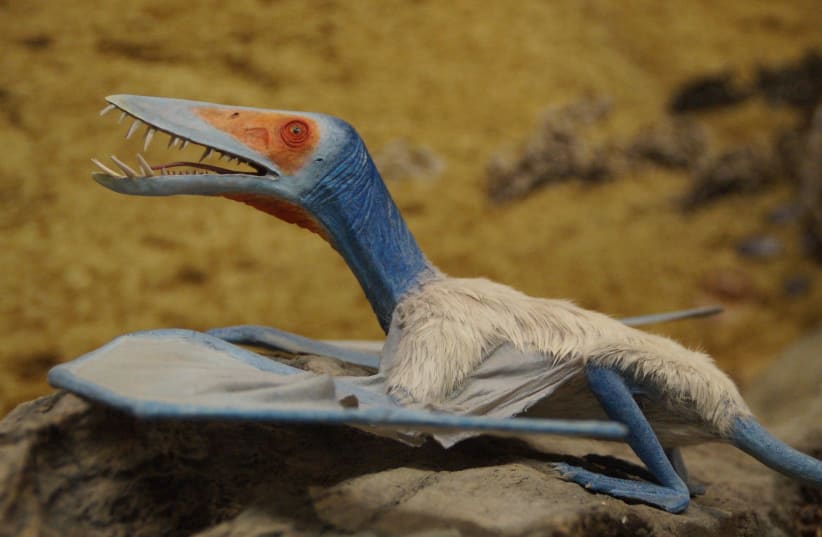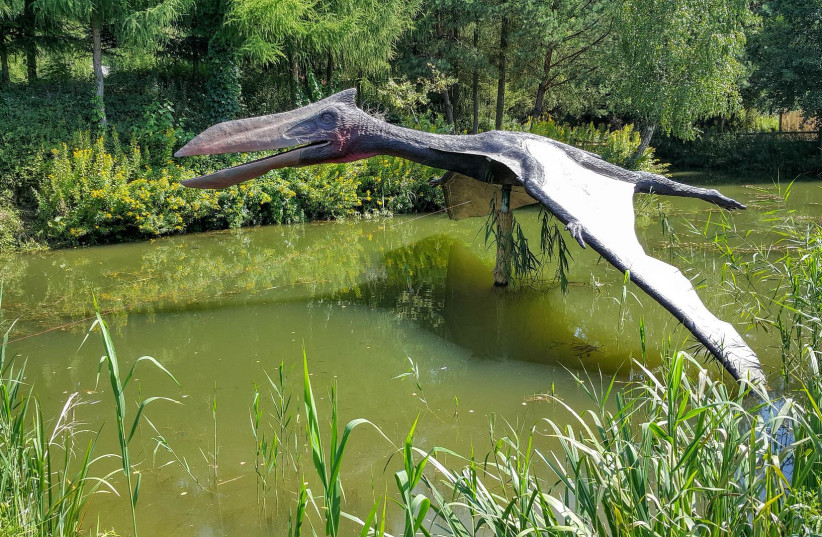The prehistoric skies over Brazil may have been more colorful than previously thought, based on findings of an international team of paleontologists which revealed that pterosaurs, the flying distant cousins of dinosaurs, were able to control the color of their feathers.
And, yes, researchers say, the pterosaurs’ fuzz was indeed feathers.
The study, published last week in the journal Nature, is based on analyses of a 115-million-year old fossilized headcrest with well-preserved soft skin tissue of the pterosaur Tupandactylus imperator from north-eastern Brazil. This species of pterosaur is famous for its huge headcrest and toothless beak.
Pterosaurs lived side by side with dinosaurs 230 million to 66 million years ago, and became extinct at the same time. Their wingspan is believed to have ranged from about 25 centimeters (10 inches) to up to 10-11 meters (33-36 feet), making them the largest animal to ever fly. The genus Tupandactylus had an estimated wingspan of about three to four meters (10 to 13 feet).
The more commonly known Pterodactyl is a specific type of pterosaur.
The recent study was led by paleontologists Dr. Aude Cincotta of University College Cork & the Royal Belgian Institute of Natural Sciences, Prof. Maria McNamara from UCC and Dr. Pascal Godefroit from RBINS, with an international team of scientists from Brazil and Belgium.
The team discovered that the bottom of the crest had a fuzzy rim of feathers, with short wiry, hair-like feathers and fluffy branched ones.
The researchers maintain that while early evolutionary history of feathers remains controversial as relevant fossils are rare and there is some academic debate about whether the pterosaur fuzz were true feathers or instead featherlike pycnofibers, their study has effectively put an end to the latter debate.
“We didn’t expect to see this at all,” Cincotta said in a UCC statement. “For decades paleontologists have argued about whether pterosaurs had feathers. The feathers in our specimen close off that debate for good as they are very clearly branched all the way along their length, just like birds today.”
THE SMALL size and lack of secondary branching in pterosaur feathers rules out active flight, but their dense packing and distribution over the body are consistent with thermoregulation, the report noted.
“This in turn is consonant with functional hypotheses for small, simple feathers in theropod dinosaurs,” they wrote in their report.
Theropods were small carnivores, herbivores or omnivores – including birds – that walked on two legs and often had feathers.
Their findings also indicate that winged reptiles developed feathers earlier than thought, shedding new light on the evolution of feathers, the researchers said.
The team studied the feathers with high-powered electron microscopes and found preserved melanosomes – granules of the natural skin pigment melanin, which mostly determines hair, skin and eye color in humans and animals.
Unexpectedly, the new study also shows that the melanosomes in different feather types have different shapes.
In birds today, feather color is strongly linked to melanosome shape, explained McNamara in the statement.
“Since the pterosaur feather types had different melanosome shapes, these animals must have had the genetic machinery to control the colors of their feathers,” she said. “This feature is essential for color patterning and shows that coloration was a critical feature of even the very earliest feathers.”
The researchers maintain that this manipulation of feather color, and therefore the function of feathers in visual communication, has “deep evolutionary origins.”
COLORATION PLAYS an important role in social signaling for animals and can be used for communication of a variety of variables such as sex, age and readiness to mate as well as for camouflage.
Researchers also noted that the common structure of the early feathers with those of dinosaurs indicates a possible shared ancestor.
“The finding extends the origins of feathers back to long before birds evolved, and sheds light on their role,” noted paleontologist Michael J. Benton of the School of Earth Sciences, University of Bristol, who was not involved in the study, in a Nature News and Views companion article.
“In a simple world, an easy classification rule is that birds have feathers, mammals have hair and reptiles have scales, as did dinosaurs," he wrote. "However, the world is not necessarily simple, and it has been known for more than 25 years that at least some dinosaurs had feathers. Previously, it was suggested that flying creatures called pterosaurs — extinct distant relatives of birds and dinosaurs — also had feathers, but that idea was controversial.”
The full origin of the fossil used in the study is unknown, but it was first collected somewhere from the Crato Formation, a geologic formation from the Early Cretaceous age in northeastern Brazil’s Araripe Basin, noted the researchers in a report summary. It was then kept in a private collection also for an unknown period of time before being deposited at RBINS.
Last October, a cooperation agreement was signed between RBINS and the Brazilian embassy in Belgium, leading to the repatriation of the fossil to the Museum of Earth Science in Rio de Janeiro, Brazil, in early February 2022. The researchers said that this enabled them to undertake their study.
“It is so important that scientifically important fossils such as this are returned to their countries of origin and safely conserved for posterity” said Godefroit. “These fossils can then be made available to scientists for further study and can inspire future generations of scientists through public exhibitions that celebrate our natural heritage.”

